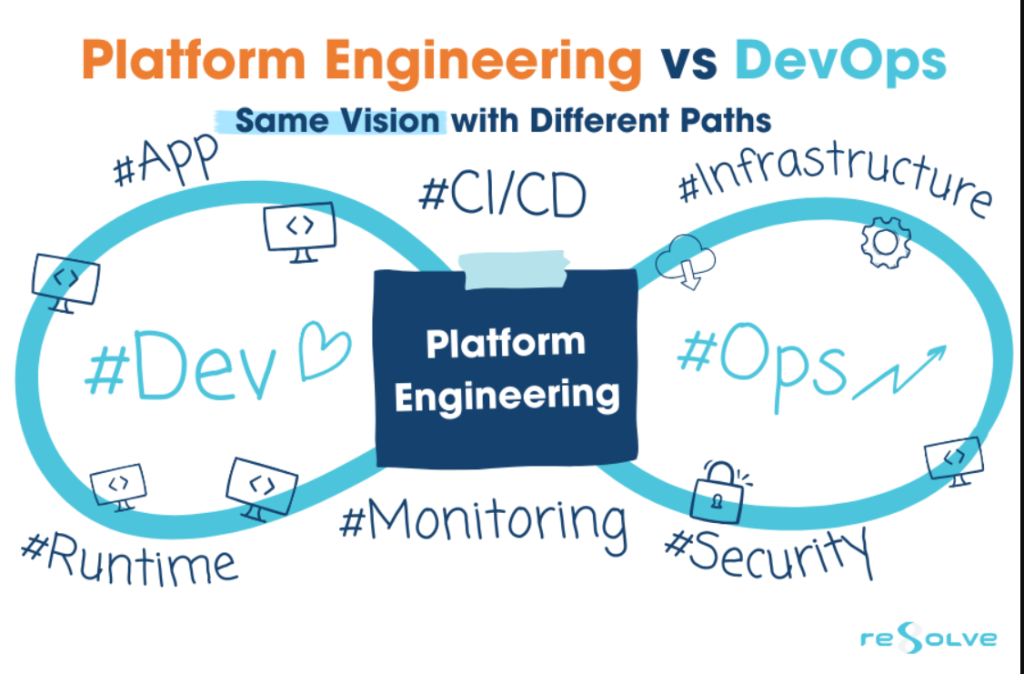
What is Platform Engineering?
Platform engineering refers to the practice of designing and building internal platforms that support software development, deployment, and operations within an organization. These platforms aim to provide a streamlined and scalable infrastructure that developers, operations teams, and other stakeholders can use to deliver software more efficiently. In modern organizations, platform engineering bridges the gap between development and operations, enabling smoother collaboration and automating many processes.
Major Features of Platform Engineering
- Automation of Repetitive Tasks: Reduces manual interventions by automating build, deployment, and monitoring tasks.
- Centralized Infrastructure: Provides a unified platform for managing infrastructure as code, CI/CD pipelines, and monitoring tools.
- Scalability and Flexibility: Ensures that the platform can grow with the organization and adapt to new tools, services, or architectures.
- Enhanced Collaboration: Enables seamless collaboration between developers, operators, and other stakeholders by providing standardized tools and services.
- Security by Design: Ensures that security considerations are built into the platform, from infrastructure to applications, reducing vulnerabilities.
The Role of Platform Engineering in DevOps
DevOps is a methodology that emphasizes collaboration, automation, and continuous improvement in the software development lifecycle. Platform engineering plays a critical role in DevOps by providing the tools and services required to implement DevOps practices effectively. A robust platform allows teams to automate manual tasks, reduce bottlenecks, and speed up the development and deployment process.
Key Aspects of Platform Engineering in DevOps
- Streamlined CI/CD Pipelines: Platform engineering enables the creation of automated CI/CD pipelines that allow for faster code integration and deployment.
- Consistency Across Environments: Ensures consistent development, testing, and production environments, reducing issues related to environment mismatches.
- Real-Time Monitoring and Feedback: Provides tools for real-time monitoring, logging, and automated feedback, helping teams detect issues early and address them swiftly.
- Collaboration Across Teams: Supports cross-functional collaboration between development, security, operations, and quality assurance teams.
Why Platform Engineering is the Future of DevOps Platforms
As organizations scale their operations and adopt more complex architectures like microservices, platform engineering has become a necessity for keeping DevOps practices effective. The future of DevOps platforms relies heavily on platform engineering as it empowers organizations to maintain agility while managing increased complexity.
Future Trends of Platform Engineering
- Shift-Left Testing: Early testing within the pipeline will be more integrated, reducing feedback loops and improving software quality.
- Hybrid and Multi-Cloud Support: Platforms will increasingly support hybrid and multi-cloud environments, giving organizations more flexibility.
- Increased Use of AI and Machine Learning: AI-powered tools will help in automating decisions related to infrastructure management, performance tuning, and more.
- Unified Observability: Platforms will offer deeper observability into all aspects of the development pipeline, from code to infrastructure.
The Benefits of Platform Engineering in DevOps
Adopting platform engineering practices brings multiple benefits to DevOps teams. By providing a streamlined, automated environment, platform engineering reduces the time to deliver software and improves the quality of products and services.
Benefits for Organizations
- Faster Time-to-Market: Automation and efficient pipelines lead to quicker releases and faster delivery of software.
- Improved Developer Productivity: Developers spend less time on repetitive tasks and can focus more on feature development and innovation.
- Cost Savings: By optimizing resource usage and automating tasks, platform engineering can help reduce operational costs.
- Enhanced Security: Built-in security measures reduce risks and vulnerabilities across the development and deployment lifecycle.
Major Challenges in Platform Engineering
While platform engineering provides numerous advantages, organizations also face some challenges when adopting these practices. Overcoming these challenges is key to building and maintaining an effective platform.
Challenges in Platform Engineering
- Complexity of Integration: Integrating new platforms with existing systems can be difficult and time-consuming.
- Skill Gap: There is a need for specialized skills in platform engineering, which can lead to difficulties in recruitment and training.
- Maintenance Overhead: Keeping the platform up-to-date and maintaining its performance requires ongoing effort and resources.
- Cultural Shifts: Adopting platform engineering may require changes in organizational culture, including a shift to more collaboration-focused and agile ways of working.
How to Get Started with Platform Engineering
For organizations looking to adopt platform engineering, there are several steps they can take to begin their journey and leverage the benefits of this approach.
Steps to Implement Platform Engineering
- Define Your Objectives: Clearly understand your goals, whether they are speed, scalability, or security, to shape your platform’s design.
- Evaluate Existing Tools: Assess the tools and technologies currently in use and identify gaps where platform engineering could provide benefits.
- Build a Cross-Functional Team: Form a team of engineers, operations experts, and security professionals to collaboratively design and implement the platform.
- Start Small: Begin with small, manageable projects, gradually scaling up as you refine your platform engineering practices.
- Focus on Automation: Ensure that automation is at the core of your platform, from CI/CD pipelines to infrastructure provisioning and monitoring.
This outline covers key aspects of platform engineering and its future in DevOps. You can expand on each section to create a comprehensive and detailed post.
